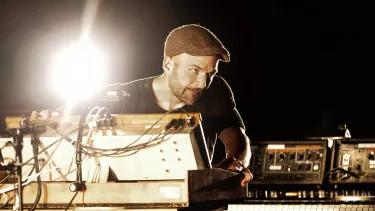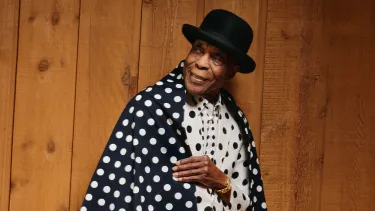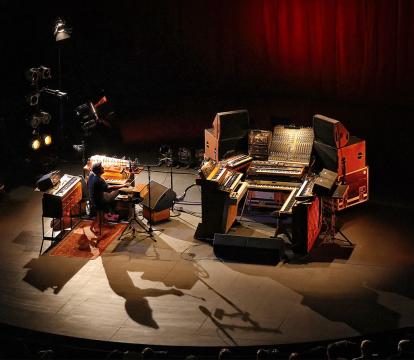Eavesdropping on Nils Frahm
FBi x Vivid LIVE New Voices Incubator recipient Cynthia Loh reflects on Frahm's extravagant yet intimate ode to the harbourside city, Music for Sydney.
It was Nils Frahm’s first live performance in almost three years, a show titled Music for Sydney. An ode to the harbourside city, the Berlin-based composer and neo-classical artist’s performance was a site-specific experience like no other.
As I arrived at the Opera House, the foyer buzzed with excitement as we waited in line to cloak our raincoats – people from different walks of life were rushing into the Opera House, hiding from the drizzle on this cold Wednesday night. Gentle mutterings floated about as the audience discussed what Music for Sydney meant – Frahm’s improvisational practice has always created an exclusive experience for each of his audiences – we were all about to share a communal sensory experience.

Frahm’s set-up lay dormant on the stage. Towering over us: monolithic monitors, two and three-tiered keyboards and pianos of differing sizes, a Eurorack with an incomprehensible number of patches. Cables and wires ran across the space, interrupted by microphone stands and stools. Spotlights illuminated the wooden slats on the back of the pianos; lighting rigs beamed in from side of stage. There was a sense of intimacy in baring the raw mechanics of the show to a 1500-large audience.
Frahm walked on stage and bowed to the audience:
“I’ve been performing in my studio and getting really into creating these melodies, and when I’m done and I look up, I feel disappointed that there’s no audience there.”
Anticipation grew as he put on a pair of gloves and approached the contraption on the left. My friend C leaned in closer to rest his chin on his hands, attempting to steal a glimpse of Frahm’s intricate movements. Frahm dipped his hands in a bowl and steadied himself before the glistening, swirling tube. From a distance, the contraption was reminiscent of a keyboard with a horizontal spiral on top. They were glass halos, laid side by side, one after the other, that spun quietly.
Towering over us: monolithic monitors, two and three-tiered keyboards and pianos of differing sizes, a Eurorack with an incomprehensible number of patches.

Frahm lifted his hands and gently touched a halo. A soft ringing. Every moment of kinetic touch between body and glass tempted the audience into an ever-expanding ambient soundscape.
It was a gentle hum. It was the glass singing. The ringing ebbed and flowed with Frahm’s touch, reverberating through the theatre.
Frahm later revealed in the show that the instrument was a glass armonica, the formal manifestation of a glass harp: a familiar contraption seen as a series of glass containers holding water that emit a hum when one runs their finger around the delicate rim. The ethereal sound echoed through the audience as Frahm played the instrument with gloves on and gloves off – an alien hum emanated from the glass armonica. We were hypnotised by his analogue orchestra, watching the shadow of the glass armonica turn in tune with Frahm’s movements in the harsh spotlight. I felt a wave of calmness wash over me. There was a delightful escape in this minimal soundscape, knowing that Frahm was about to take us on a sonic journey.

He walked across the space with steadiness, approaching his set-up with practised familiarity. Tinkering with the synth, Frahm began to layer his soundscape with a growing wave, a repetitive “thud”, each louder than the last. Swivelling around on his stool, he then focused on the piano.
Sitting near the top of the Joan Sutherland Theatre, I marvelled at how minuscule Frahm looked compared to his contraptions. He was the sole conductor of all these elements, masterfully weaving between instruments, sometimes playing two keyboards at once, with his arms overlapping each other, reaching across the set-up. The soundscape, by contrast, was minimalistic yet all-encompassing, swallowing us into the belly of the show.
There was a tactility in the way Frahm performed. The microphones picked up every keypress; every whisper as he shuffled across to another synth; the rustle of his clothes. Frahm, for the duration of the two-hour performance, conjured up melodies that drew us into a vacuum of his creation. Crucially, he engaged the intricacies and minuscule sounds in a subtle conversation with a larger soundscape – one that we had the privilege of eavesdropping on.
Frahm, for the duration of the two-hour performance, conjured up melodies that drew us into a vacuum of his creation.


You may also like




